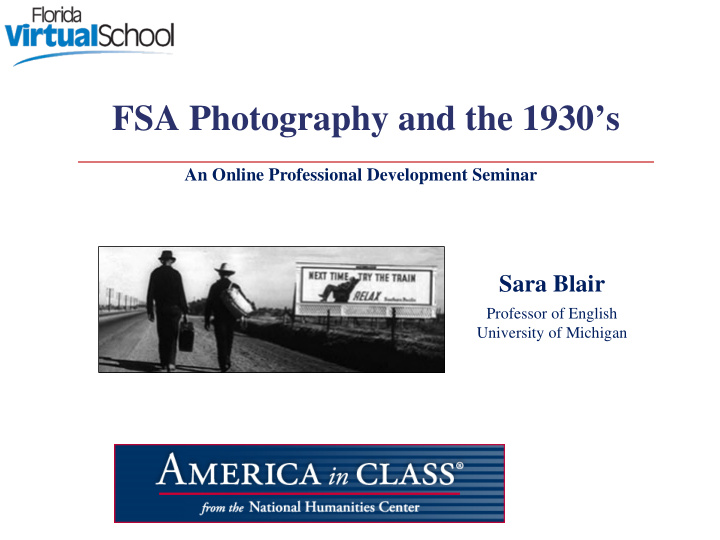



FSA Photography and the 1930’s An Online Professional Development Seminar Sara Blair Professor of English University of Michigan We will begin promptly on the hour. The silence you hear is normal. If you do not hear anything when the images change, e-mail Caryn Koplik ckoplik@nationalhumanitiescenter.org for assistance.
FSA Photography and the 1930’s FROM THE FORUM How do we get students to analyze photographs instead of just viewing them? How did photojouralism evolve? Why are there so many iconic photos from the Great Depression? Were the documentary photos of the 1930s staged, as were the iconic photos of the Civil War? What impact did the FSA photos have? What was the purpose of the FSA photography program? Were the FSA photos intended to be propaganda or documentation? To what extent are the FSA photos and photojournalistic images like them objective? 2 americainclass.org
FSA Photography and the 1930’s FRAMING QUESTIONS What does the FSA photographic archive teach us about the Great Depression? How were the images made, and what were their aims? What understanding of America’s shared history do these images make possible? How can we critically engage these photographs and use them as learning tools? 3 americainclass.org
Sara Blair Professor of English University of Michigan Primary Interests: late nineteenth- and twentieth-century American culture, photography and visual culture, modernism and modernity. Trauma and Documentary Photography of the FSA co-authored with Eric Rosenberg (2012) Harlem Crossroads: Black Writers and the Photograph in the Twentieth Century (2007) 4 americainclass.org
FSA Photography and the 1930’s Analyzing Photographs: What’s in a Picture Who, what, where: What can we say about the event or action the photograph records? Subject matter: Why did the photographer include these particular elements? What don’t you see in the picture? Composition & framing: How do people or objects fill the frame? What’s in focus (or not)? Where does your eye go as you look at the photograph? Capture: What might have happened just before or after this picture was taken? What kind of moment is captured? Perspective: Why did the photographer take the picture from this angle? What would the scene have looked like from another vantage point — from left, right, behind, above, or below? 5 americainclass.org
FSA Photography and the 1930’s What were the FSA photographs? Body of 250,000 images created between 1935 and early 1940s Funded by the Resettlement Administration of the FSA Intended to build popular support for federal spending on relief programs Paid for photographers to work on specific projects across the U.S. Created the largest public archive of American life in U.S. history 6 americainclass.org
FSA Photography and the 1930’s John Thomson, London Nomades, 1876 7 americainclass.org
FSA Photography and the 1930’s A shantytown in New York, Daily Graphic, 1880 (first photograph reproduced in a daily newspaper) 8 americainclass.org
FSA Photography and the 1930’s Jacob Riis, Five Cent Lodging, 1889 9 americainclass.org
FSA Photography and the 1930’s Marion Post Wolcott, Migrant Workers Waiting for Pay, Florida, 1939 10 americainclass.org
FSA Photography and the 1930’s Dorothea Lange, Migrant shed worker, northeast Florida, 1936 11 americainclass.org
FSA Photography and the 1930’s Walker Evans, Lucille Burroughs, daughter of a cotton sharecropper, Hale County, Alabama, 1936 12 americainclass.org
FSA Photography and the 1930’s Ben Shahn, Boone County, Arkansas. The family of a Resettlement Administration client in the doorway of their home, 1935 13 americainclass.org
FSA Photography and the 1930’s Walker Evans, Wash stand in the dog-run of Floyd Burroughs’ house, Hale County, Alabama, 1936 14 americainclass.org
FSA Photography and the 1930’s Walker Evans, Floyd Burroughs’ Work Shoes, Hale County, Alabama, 1936 15 americainclass.org
FSA Photography and the 1930’s 16 americainclass.org
FSA Photography and the 1930’s 17 americainclass.org
FSA Photography and the 1930’s 18 americainclass.org
FSA Photography and the 1930’s 19 americainclass.org
FSA Photography and the 1930’s Dorothea Lange, Migrant agricultural worker's family. Seven hungry children. Mother aged thirty- two. Father is a native Californian. Destitute in pea picker's camp, Nipomo, California, because of the failure of the early pea crop. These people had just sold their tent in order to buy food. Of the twenty- five hundred people in this camp most of them were destitute, 1936 20 americainclass.org
FSA Photography and the 1930’s Dorothea Lange, Destitute pea pickers in California. Mother of seven children. Age thirty-two. Nipomo, California, 1936 21 americainclass.org
FSA Photography and the 1930’s 22 americainclass.org
FSA Photography and the 1930’s 23 americainclass.org
FSA Photography and the 1930’s Florence Thompson Castle with Dorothea Lange’s portrait of her as “Migrant Mother” 24 americainclass.org
FSA Photography and the 1930’s Arthur Rothstein, The Bleached Skull of a Steer on the dry sun-baked earth of the South Dakota Badlands, 1936 25 americainclass.org
FSA Photography and the 1930’s Carl Mydans, Abandoned land and poor pasture at Florida Withlacoochee River Agricultural Demonstration Project near Brooksville, Florida, 1936 26 americainclass.org
FSA Photography and the 1930’s Walker Evans, Bethlehem graveyard and steel mill, Pennsylvania, 1935 27 americainclass.org
FSA Photography and the 1930’s Dorothea Lange, Plantation overseer near Clarksdale, Mississippi, 1936 28 americainclass.org
FSA Photography and the 1930’s Ben Shahn, Medicine Show, Huntingdon, Tennessee, 1935 29 americainclass.org
FSA Photography and the 1930’s Ben Shahn, Cotton pickers, Pulaski County, Arkansas, 1935 30 americainclass.org
FSA Photography and the 1930’s Dorothea Lange, Toward Los Angeles, California, 1937 31 americainclass.org
FSA Photography and the 1930’s Gordon Parks, Washington, D.C., government charwoman, 1942 32 americainclass.org
Final slide. Thank You 33 americainclass.org
Recommend
More recommend